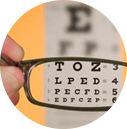A clear vision is the result of the passage of light through an eye with perfect form, allowing a clear focus on the retina.
There are imperfections that affect various structures of the eye –cornea, crystalline, retina– which cause “refractive errors”. The most common are the following:

Myopia (nearsightedness)
It occurs when the cornea is too curved and/or the eye is very long, so the light focuses before reaching the retina, causing distant objects to appear blurred.

Hyperopia (farsightedness)
It occurs when the cornea is too flat and/or the eye is very short. The light focuses after reaching the retina, causing nearby objects and, in some cases, distant objects to appear blurred.

Astigmatism
It occurs when the cornea is oval shaped and causes light to focus in more than one place in relation to the retina, which causes both near and far images to appear blurry and distorted.

At the Espaillat Cabral Institute, we use the most advanced technology for FemtoLasik. We have the VISUMAX 800 femtosecond laser and the MEL 90 excimer laser for the precise correction of myopia, hyperopia and astigmatism. This technology is 100% scalpel-free and offers unprecedented precision in corrective visual procedures.

In the first stage, the VISUMAX 800 femtosecond laser is used to create a thin flap in the cornea with exceptional precision, facilitating rapid recovery and reducing the risk of complications. Once the flap is created, it is lifted to expose the underlying corneal tissue.
Next, the MEL 90 excimer laser is used to perform corneal ablation, that is, to sculpt and remodel the surface of the cornea. After remodeling, the corneal flap is repositioned without the need for sutures, allowing rapid natural adhesion. The combination of these advanced technologies guarantees optimal visual results and a quick recovery for the patient.

FemtoLasik has the potential to improve, not only how much the patient sees, but the quality of vision, improving aspects such as the ability to differentiate nuances in colors and brightness; the quality of night vision; decreasing or eliminating glare or sensitivity to light at night.
Prior to the procedure, the ophthalmologist performs a general ocular evaluation and performs specialized diagnostic studies to determine if the patient is a candidate. The patient must: be 21 years of age or older; have a stable prescription for more than one year and healthy corneas. People with certain medical conditions, pregnant and lactating women are not candidates.

FemtoLasik is an outpatient procedure that only requires topical anesthesia (drops).
Recovery time is minimal: patients may return to work the day after the procedure. The rest period for intense reading is two to three days.
The end result is the clearest possible vision, reducing or eliminating the need for glasses or contact lenses. The correction achieved is evident from the following day and the final vision stabilizes during the following few days.




















